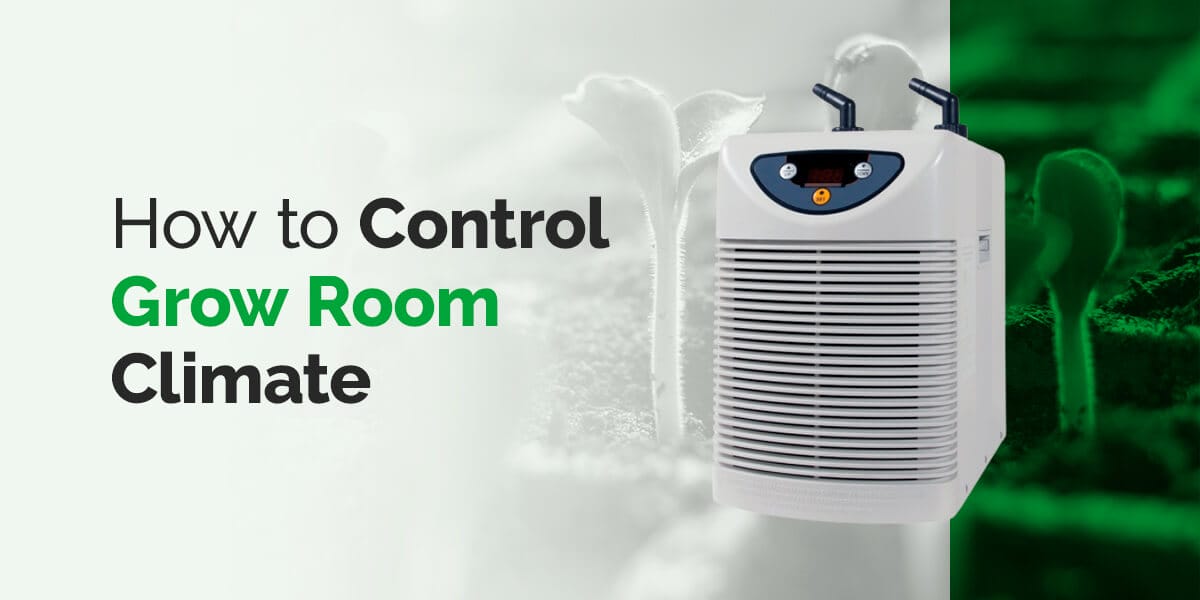If you’re a fan of fresh produce, herbs and flowers, or a gardening enthusiast, you might be wondering, “Should I buy a grow tent?” With proper use, these allow you to produce plants year-round, even in the harshest climates. Anyone who has ever tried to grow plants, indoor or outdoor, knows how finicky and temperamental they can be. Plants are needy. They require a specific temperature and the correct amount of light and water, plus a nutrient-rich medium, clean air quality and protection from pests. A grow tent provides all these, while requiring little energy and taking up a small space. With a grow tent, you can create the right environment for plant growth, regardless of the weather outside.
For a good reason, grow tents are a beloved plant-growing solution. They’re affordable for the hobbyist, can fit nearly anywhere and yield impressive results. They offer total environmental control, so you can create ideal conditions for any plant. Read on to learn all about grow tents — what they are, how they work and what you can grow in them.

What Are Grow Tents?
Grow tents provide an indoor solution for growing plants. Many growers use them for cannabis crops, but you can use yours to grow many other plants as well, including vegetables. A grow tent has a solid frame and a fabric cover, secured with zippers. It’s lightweight, making it easy to set up and move around as needed. While other options are available, such as grow cabinets, none are as portable or simple as a grow tent. A complete grow tent setup is straightforward, with only a few necessary elements. An successful grow tent requires:
- A fabric of sturdy canvas with reflective material on the inside.
- An air filtration system for clean air circulation.
- A grow light kit of the appropriate size and power level.
- Meters and timers for easier control.
- Plant containers, grow media and nutrients.
Depending on the plants you hope to grow, you’ll need assorted containers, nutrients and growing media. You might opt for a hydroponic system, which does not require any traditional soil. Various soil and soilless mixes are best for different plants, so do some research about the plants you hope to grow. You might also need pest or odor control solutions. Learn how grow tents work to create an ideal environment for plants.
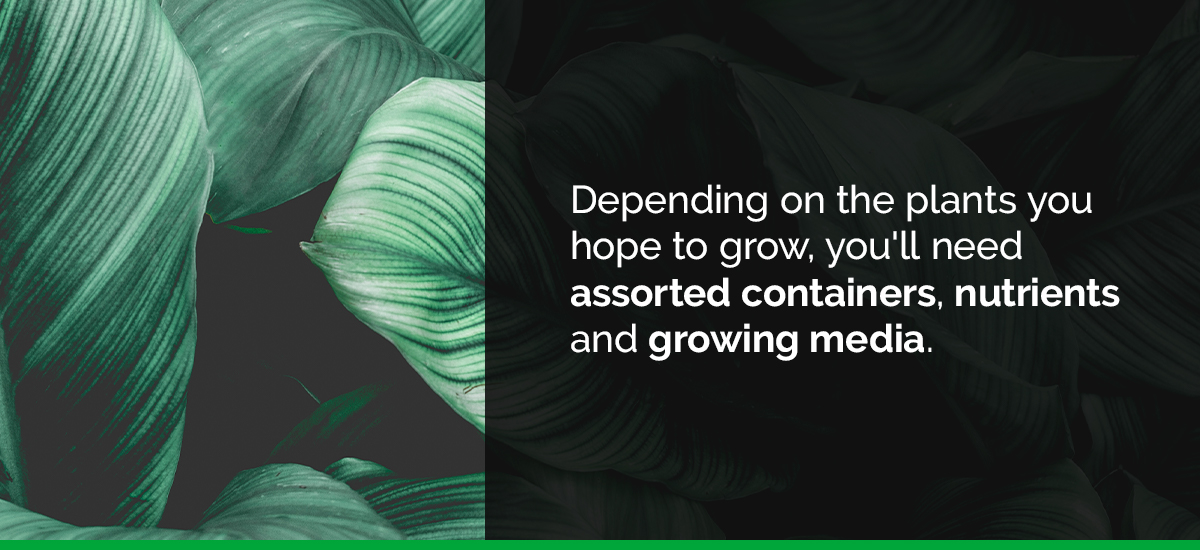
How Do Grow Tents Work?
A grow tent provides an enclosed space so you can control the temperature, lighting and other environmental factors, offering plants perfect conditions for growth. You can grow different plants with diverse environmental needs in separate tents, side by side. This versatility adds a level of convenience new to the world of agriculture. Because grow tents offer so much environmental control, you can place them anywhere — in a closet, a garage, an attic or a basement. All you need in your setup location is access to power, but grow tents are energy-efficient. A grow tent’s inner workings are more sophisticated than many realize.
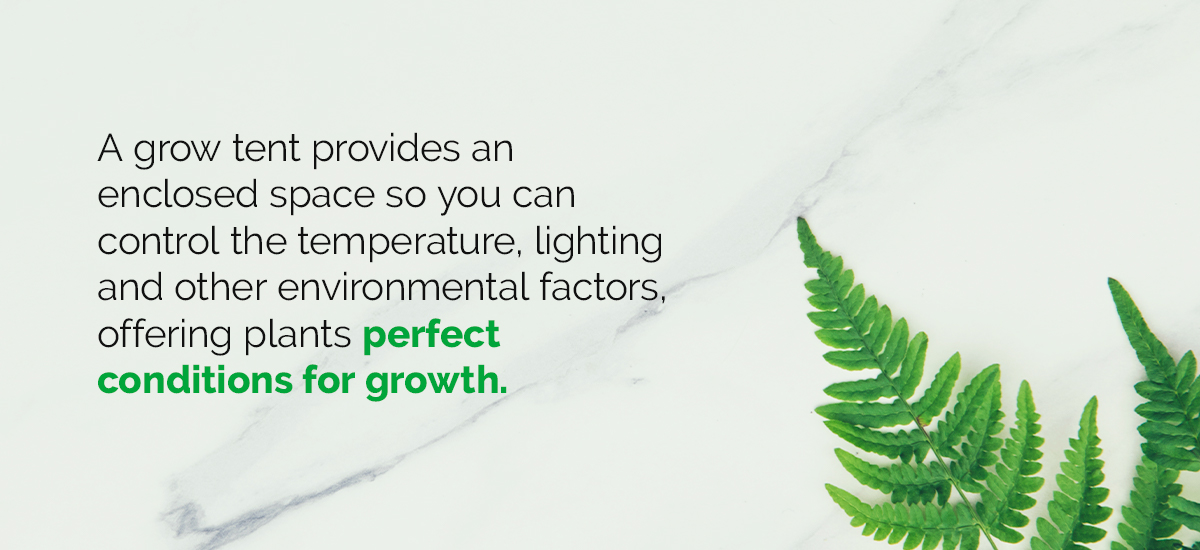
Reflecting Light
The tent fabric’s interior is a reflective material, which intensifies and diffuses light. This setup maximizes the available light, resulting in an energy-efficient system. As a result, you can place your grow tent anywhere, even if there’s limited access to natural light. Be sure to use a light system with the appropriate wattage for your application.
Correct light usage is one of the essential elements of an effective grow tent. If the light is too powerful, it might create too much heat for your plants. On the other hand, too little light will leave plants undernourished. The lighting type you choose should depend on several factors, including your tent’s size, the number of plants in your tent and your desired yield. Lighting options include:
- Light-emitting diodes.
- Fluorescent lights.
- High-intensity discharge lights.
- Induction bulbs.
- High-pressure sodium lights.
- Ceramic metal halide lighting.

Keeping Pests Away
A grow tent’s closed-off environment provides better pest control than you can achieve with conventional gardening. Only the smallest pests have any chance of reaching your crops. While indoor plants are not immune to pests, the risks are much lower. You might need pest control solutions to deal with fungus, spider mites or other insects, but you’ll never find a rabbit or groundhog chomping on your vegetables. For many, improved pest control is a significant benefit of grow tents.
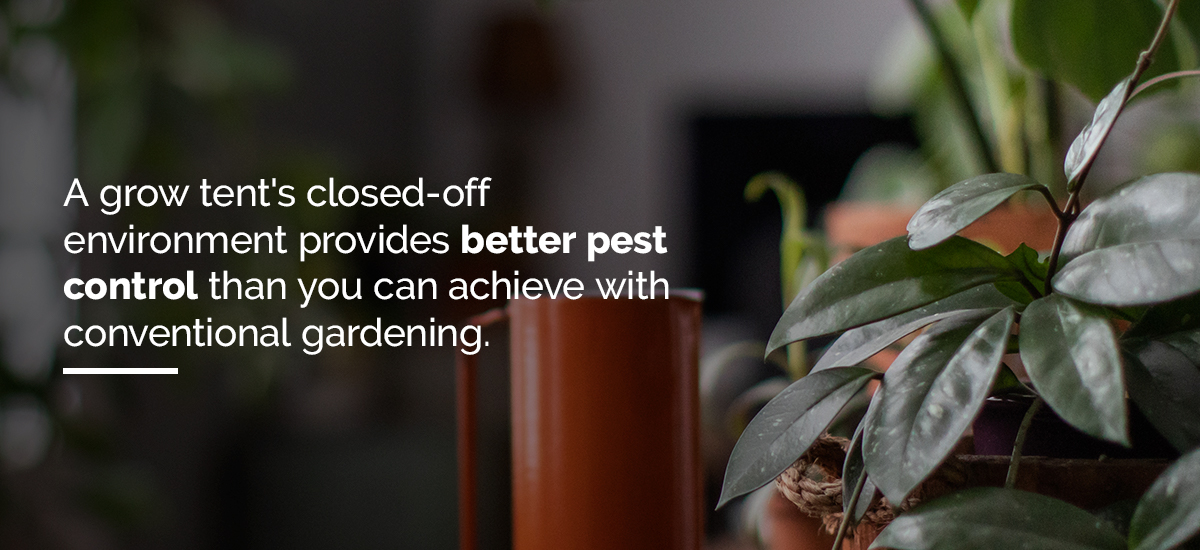
Circulating and Cleaning Air
You may be wondering how your plants will have access to fresh air in a closed environment. That’s where air filtration systems come in. Several methods are available for air circulation and climate control. A simple fan and ducting system can help plants succeed, while HEPA filters reduce harmful particles and odors. For the best air quality, some plants also require dehumidifiers and carbon dioxide control equipment. The air circulation setup’s complexity depends on the tent’s size, ambient conditions, and the number and species of plants within.
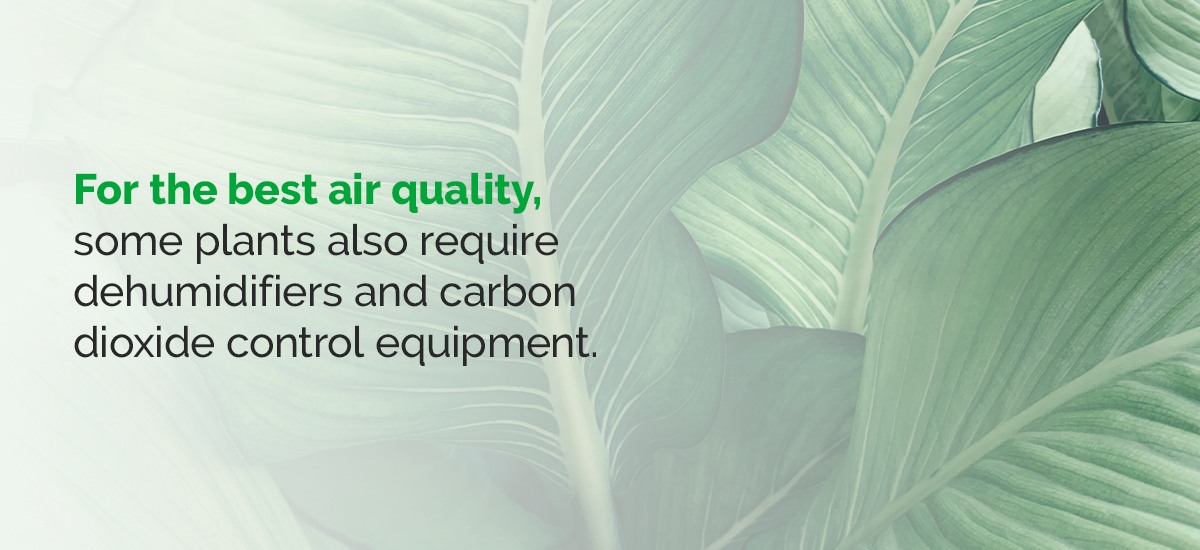
Controlling Temperature
A stable temperature within a comfortable range is crucial for plant growth. Grow tents allow you to adjust the temperature using fans, dehumidifiers, ventilation systems and lighting solutions. Outside, there’s little you can do to regulate the temperature. Farmers and gardeners know all too well what can happen when temperatures fluctuate without warning. An unanticipated frost or heat wave can destroy entire crop fields. Predictability and control are additional grow tent advantages.
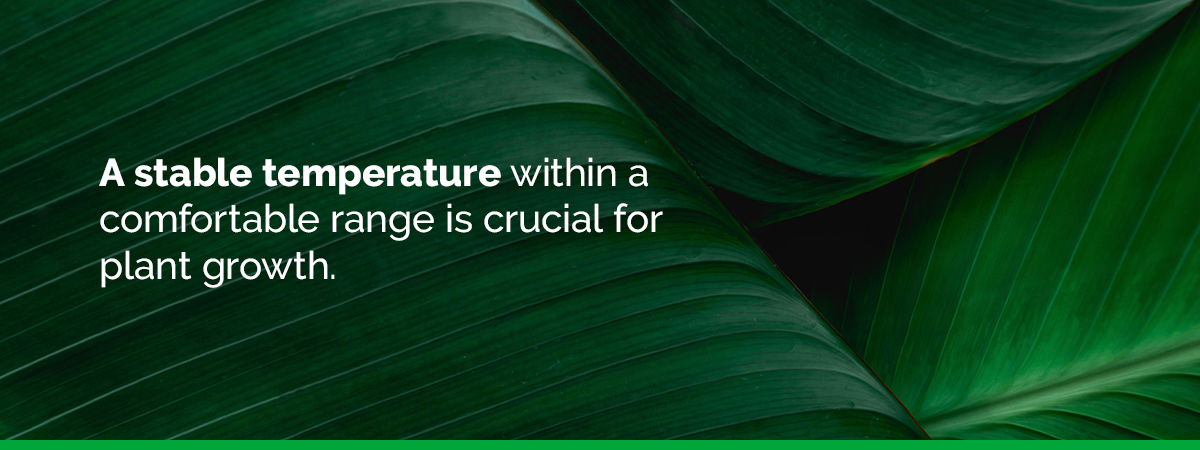
Providing Nutrients and Water
Of course, plants need nutrients and water to survive. Several methods are available for providing nutrients and water within grow tents. Some growing media include soil, while others are soilless. Each has unique benefits for promoting healthy plant growth. Various grow media include:
- Traditional soil.
- Fast-draining soil to minimize water over-retention.
- Clay pebbles for a hydroponic system.
- Grow stone, also ideal for a hydroponic system.
- Perlite and vermiculite, which are lightweight sand substitutes.
- Rockwool, made from basalt rock fibers.
In addition to the grow medium, many grow tent users provide extra nutrients for their plants. Nutrients can serve several different purposes for plant growth. They can fall into any of these categories.
- Base nutrients: Necessary for healthy growth, base nutrients include potassium, phosphorus and nitrogen.
- Conditioners: These improve soil health and maintain the cleanliness of the system.
- Supplements: Supplements help fulfill any nutrient deficiencies. They can include vitamins, amino acids, silica or calcium magnesium.
- Enhancers: These help boost plants’ flowering stage for a more dramatic result.
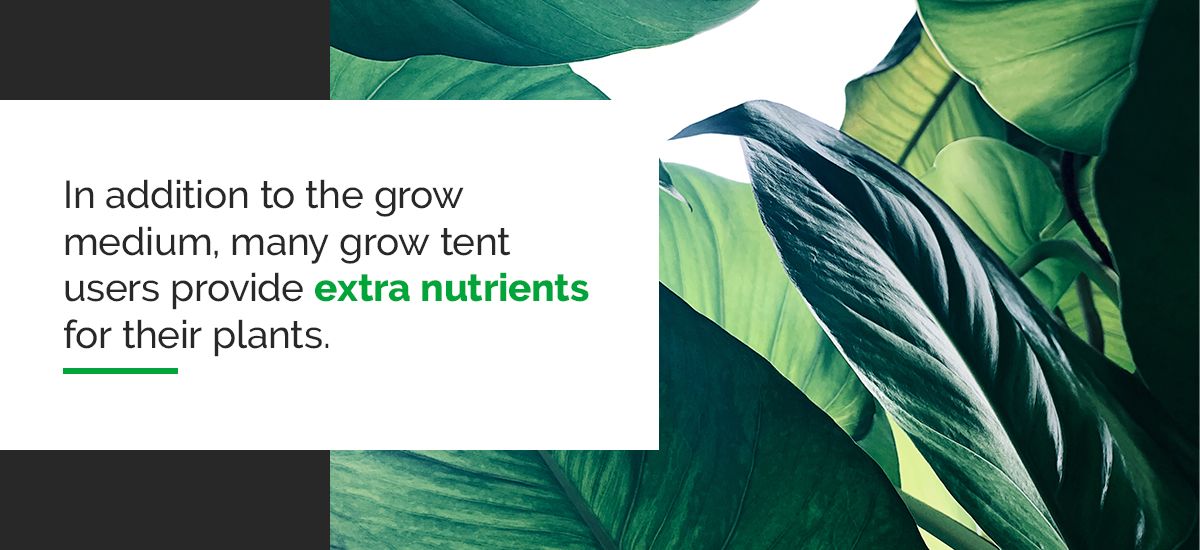
Types and Sizes of Grow Tents
If you’re wondering what grow tent you should buy, you have plenty of options. Grow tents come in many different types, shapes and sizes. One of their significant benefits is that you can use as much or as little space you have available. You need not dedicate an entire room to your plant-growing hobby, but you can if you choose to. You can also put multiple tents together to create diverse environments for different plants. Grow tents allow for plenty of creativity and innovation.
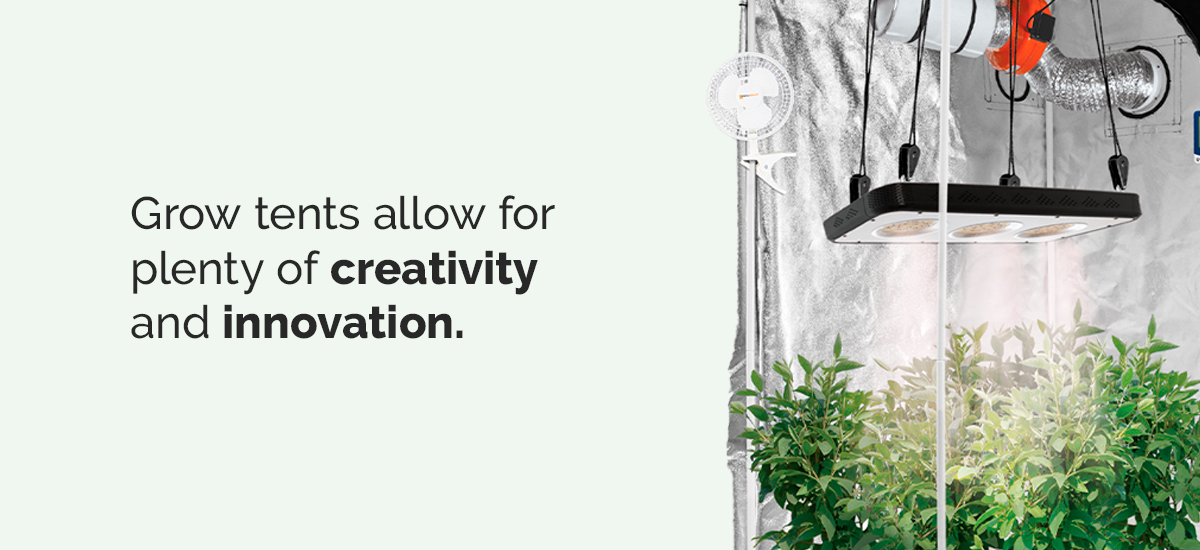
What Are the Sizes of Grow Tents?
Depending on how much space you have available and how many plants you hope to grow, you’ll have the opportunity to choose from various grow tent size options. Grow tents can be of many different dimensions. Some standard grow tent sizes include:
- 4′ x 8′.
- 3′ x 3′.
- 4′ x 4′.
- 2′ x 4′.
When deciding on the tent size that’s right for you, consider several factors. First, measure how much space you have available for your grow tent. Then, think about the plant species and its environmental needs. Consider how much horizontal and vertical space it requires for proper growth, as well as how much light and warmth it needs. Another crucial consideration is the growing system you want to create.
What Are the Types of Grow Tents?
Several different grow tent kits are available for various purposes. Each tent has unique benefits and requires varying experience levels to maintain. Learn about the types of grow tents you can choose from.
1. Soil Tent Kits
A traditional soil system has a lower upfront cost than a hydroponic system. Of course, soil provides a natural medium for plants to grow — plants have grown in soil for millions of years. You can opt for a faster-draining soil to minimize water over-retention, and you can add supplemental nutrients for healthier, sturdier plant growth. It’s best to purchase a soil mix rather than collecting dirt from your yard, as you’ll risk bringing in pests if you do the latter.
2. Hydroponic Tent Kits
Though hydroponic tent kits can have a higher upfront cost, their effectiveness pays for itself. A hydroponic tent kit should include a grow light, a hydroponic planter system, a grow medium and a nutrient package. Read more about hydroponic systems in the frequently asked questions section below. This innovative way to grow plants offers efficient use of resources.
3. Do-It-Yourself Tent Materials
You can personalize your grow tent to your exact specifications with do-it-yourself materials. If you’re a beginner, you might want to start with a premade kit. However, DIY materials allow you to create a tent with the precise dimensions you prefer.
What Are the Best Grow Tents?
The best grow tent for you depends on several factors — the plant species you hope to grow, how many plants you want your tent to contain, the growth system you prefer and how much room you have available. Do some research on your preferred plant species. Consult beginner to advanced guidebooks, discussion boards, agricultural almanacs and other resources. For total customization freedom, you can construct a homemade tent with DIY materials.
What Can You Grow in a Grow Tent?
You can grow almost any plant in a grow tent if you have the appropriate environmental controls and adequate horizontal and vertical space. With a grow tent, you can continue gardening year-round. Some use grow tents to produce cannabis, while others grow vegetables, herbs or flowers. If you have a green thumb, but live in harsh climate conditions, grow tents offer an affordable way to keep gardening all year.
As a rule of thumb, most plants need about twice as much artificial light as they do sunlight. Please note that the following lists are not exhaustive. If you’re interested in growing a plant that is not in the list below, go for it! Be sure to research the plant’s needs, so you can create the best possible environment.

Can You Grow Vegetables in a Grow Tent?
You can grow all kinds of vegetables, herbs and flowers in your grow tent. You need not worry about which plants are “in season” — you’ll be creating the weather within your grow tent. If you enjoy cooking, you understand the pitfalls of buying produce from a grocery store. Sometimes, produce must travel long distances, losing its flavor and nutrient value along the way. You can grow edible plants for farm-to-table cooking. Here’s some popular produce you can grow indoors.
- Tomatoes: You might opt for dwarf or cherry tomatoes, depending on the amount of room you have available.
- Carrots: Remember, carrots grow underground, so you’ll need wide, deep pots to accommodate carrot growth. You could choose to plant miniature or “baby” carrot strains to take up less space.
- Mushrooms: Mushrooms are excellent for beginners because they proliferate rapidly. Within a few days, you’ll know whether your mushrooms are thriving, and you can adjust as needed.
- Spinach: Most spinach varieties take about a month to grow, give or take a few days. They only require a few inches of soil, so they’re an ideal option for limited space. Spinach has many health benefits and can elevate plenty of recipes.
- Lettuce: Because lettuce requires a lot of light, a grow tent is a perfect environment. That’s especially true if you live in a climate with many overcast days. It’s also an excellent plant for testing a hydroponic system.
- Kale: Like lettuce, kale prefers full sun, which makes a grow tent an ideal environment. Ensure you provide adequate growing space, as kale roots grow horizontally.
- Arugula: Arugula has no trouble growing in cooler temperatures. It’s a smart choice if you’re going to place your grow tent in an attic, garage or any other space with only moderate insulation in the colder months.
- Swiss chard: This plant species is another good choice for beginners, as swiss chard is a hardy crop. It’s similar to lettuce or spinach in its needs.
- Mustard greens: It’s a wonder mustard greens aren’t more popular, given their high iron content and multiple health benefits. They make an exceptional addition to a grow tent garden — and to a regular diet.
- Radishes: Like spinach, radishes take about a month to grow. If you choose to include radishes in your grow tent, be sure to keep them well-watered. They thrive with soil that feels moist to the touch.
- Beets: Beets and radishes need similar conditions. Use somewhat generously sized growing pots for either, as they need a decent bit of space.
- Ginger: Ginger is a versatile plant, delicious for making curry or adding spice to a stir-fry. Note that ginger prefers warmer temperatures.
- Onion: Onions need a bit of vertical growing space, so remember that as you set up your tent. They also take a bit longer to grow than other vegetables, reaching maturity after a few months.
- Bell peppers: Bell peppers are an excellent starter plant if you’ve never used a grow tent before. They need full sun — use a red-toned artificial light for the best results.
- Green beans: You’ll need a lot of vertical space if you hope to grow green beans, so ensure there’s adequate distance between your planters and your light source.
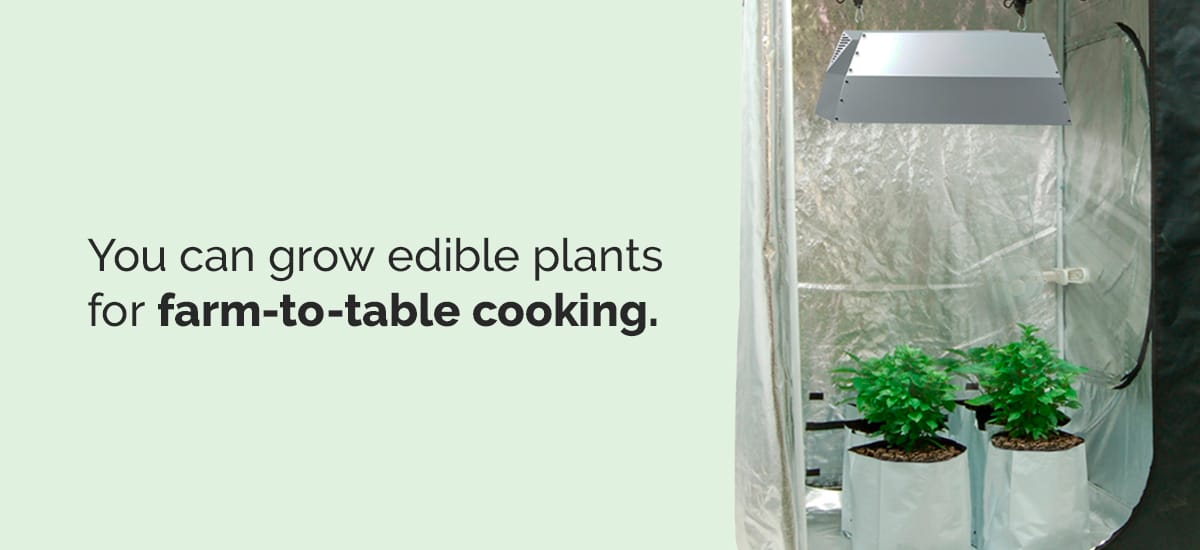
What Else Can You Grow in a Grow Tent?
You can also grow herbs in your grow tent to add some flavor to your meals. Instead of maintaining these plants on your kitchen windowsill and exposing them to light and temperature fluctuations, you can promote herbs’ vitality by nurturing them in a grow tent. Here are some spices you can grow in your tent.
- Rosemary: Ensure you have plenty of vertical space and provide plenty of light. With its Meditteranean origins, rosemary prefers dry, well-drained soil.
- Basil: Basil needs little space to grow, which makes it perfect for a small grow tent.
- Parsley: Rich in iron and vitamins, parsley is an excellent addition to a spice garden. This plant requires some horizontal space for healthy growth.
- Mint: Mint tends to take over large gardens with its prolific growth. Keep it separate from other plants, and you’ll have plenty of mint leaves to garnish your mojitos.
- Thyme: Thyme needs minimal growing space, much like basil.
If you’re more of a botanist than a chef, you can also use your grow tent to produce flowers. Make sure to adjust your light source, since flowers grow taller than other plants. Here are some popular flower species that thrive with artificial light.
- Roses: Rosebushes prefer direct sunlight, so a regulated artificial light schedule can produce robust, healthy roses.
- Poinsettias: Native to Mexico, poinsettias are a beloved holiday plant. They prefer warmer temperatures and somewhat dry, not saturated, soil.
- Orchids: An orchid will thrive with fast-draining soil, not overwatered. Make sure your tent has plenty of vertical space for the orchids to grow.
- Hibiscus: Since hibiscus plants are tropical, they enjoy full sun and moist soil. Water them often, never allowing their soil to dry out.
- African violets: An African violet can be picky, so it’s essential to keep its environment regulated. Keep humidity levels low and avoid getting water on the leaves. If the leaves become wet, they can rot and wither.
- Chrysanthemums: With their beautiful, wide blooms, chrysanthemums prefer warmth and light. They’re summer plants, so a grow tent is necessary if you hope to grow them in winter.
- Azaleas: Azaleas have shallow roots and prefer well-drained soil. They favor partial sun, so you’ll need an appropriate light schedule.
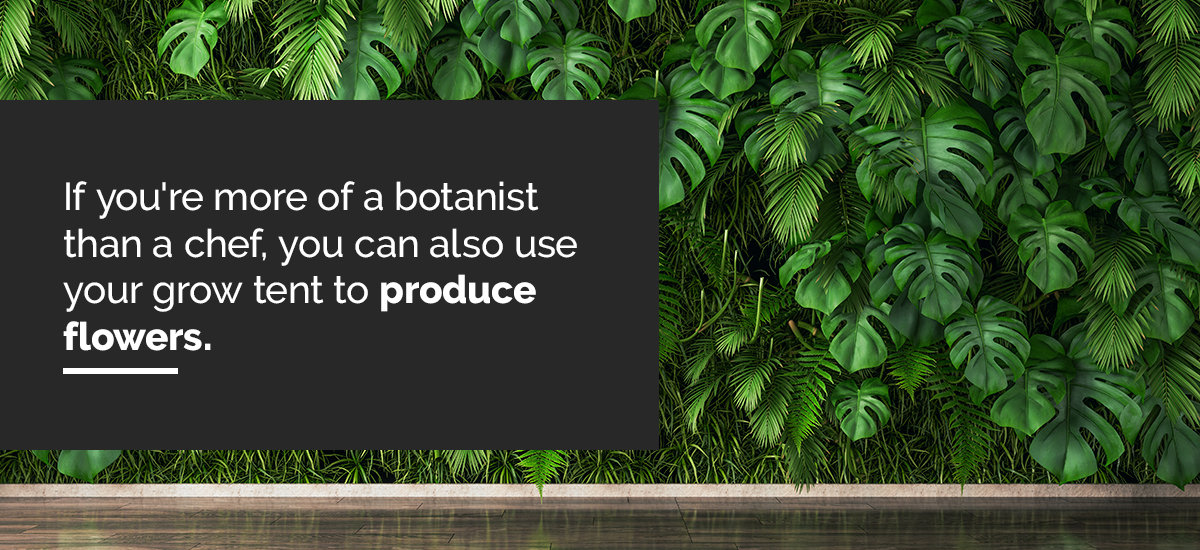
Grow Tent Frequently Asked Questions
If you’re a grow tent beginner, you might have a few questions. Setting up a grow tent can seem complicated at first glance, with several parts and components, but maintaining a grow tent is simpler than you might think. Here are answers to some of the most frequently asked questions about grow tents.
How Do I Assemble My Grow Tent?
A grow tent is easy to assemble using a few tools.
- After you connect the frame’s pieces, attach the canvas with the reflective side facing inward.
- Install your filters, fans and lights by attaching them to the roof bars, then fasten your thermometer and hygrometer.
- Fill your pots with soil or soilless mixture, and be sure to use a pH monitor in a hydroponic system.
- Place your plants within their containers, allowing adequate space between each for root growth.
- Ensure your lights are an appropriate distance from your plants — they should be close enough to provide total coverage, but far enough that your plants’ leaves will be safe from burning. Remember, each plant species has unique needs, so you’ll need to adjust appropriately.
- Once your plants are in place, set timers on your lights. Close the zippers on your tent after caring for your plants and checking your monitors.
Can a Grow Tent Catch Fire?
Any objects in your home that use electricity can become fire hazards with improper use, and grow tents are no exception. If you have a grow tent, it’s crucial to follow necessary fire safety procedures. Ensure your tent’s canvas is a thick, durable material and your lights are high-quality. Keep flammable objects at an adequate distance from the light. Keep electronic components separate from water and use reliable wiring. As an added precaution, always have a smoke detector near your grow tent.
Learn more about fire prevention and escape procedure. Always have a plan if a fire occurs, and ensure everyone in your home is aware of your safety plan. As long as you use high-quality materials and take necessary precautions, there’ll be no more risk than there is with any of your other household appliances. Still, it’s better to be safe than sorry.
Do Grow Tents Keep the Smell In?
A grow tent is not smell-proof, but you can install odor control devices. A carbon filter with a fan will trap odor particles, forcing the smell out of the air. Another solution is an ozone generator, which breaks down odor molecules. As you harvest your plants, removing them from the tent, you can use odor-proof containers for storage.
Can I Leave My Grow Tent Open?
One of grow tents’ primary advantages is that they create an enclosed environment, separate from the rest of your home. If you leave your grow tent open, you’ll have less control over your plants’ environment. That will make it challenging to regulate the temperature, humidity and air quality. Leaving your tent open may also attract pests into your home, including mites and ants.
If you want to leave your tent open because the internal temperature is too high, consider supplementing or adjusting your climate control equipment. Install fans, carbon filters and dehumidifiers. Run them as needed, keeping an eye on your monitors. You may have an excess of heat due to an over-powerful light fixture. When you put together your tent, make sure your light fixture is an appropriate size and wattage. It’s a good idea to buy a complete kit from a reputable grow tent supplier, as it will include a suitable light.
Where Should I Put a Thermometer or Hygrometer?
You’ll want to be able to check on the temperature and humidity levels inside your tent at a glance, so you can adjust equipment as needed. It’s smart to have both a thermometer and a hygrometer, which reads humidity levels. Place them at the root level and the top of the canopy near the light. The desired temperature and humidity levels will depend on the plants you’re growing. Most plants are sensitive to extreme temperatures, whether hot or cold. If your tent is too hot, increase the ventilation with fans and other equipment. If your tent is too humid, use a dehumidifier.
What Do I Have to Do to Maintain My Plants in a Grow Tent?
When you use a grow tent, your plants will require minimal care. All you’ll have to do is water your plants, read your monitors, adjust settings as needed and keep the tent’s interior clean. You may also want to add nutrients to your soil to supplement or enhance plant growth. Of course, some plants require more attention than others — you may have to water or prune some species a few times a day.
You can put your lights on an automatic schedule to ensure your plants receive adequate light exposure. Keep an eye on your monitors to maintain ideal conditions. Regularly check your soil’s temperature and hydroponic water solution, plus pH and humidity levels. Adjust any equipment as needed. With minimal supervision, your plants will thrive in a grow tent.
How Can I Keep My Grow Tent Clean?
It’s critical to maintain your grow tent’s cleanliness. A messy grow tent can harbor bacteria, plant viruses, insects or mold, rendering your produce inedible. Keep your grow tent clean by clearing debris from the floor and sanitizing surfaces. Be sure to wear personal protective equipment, including gloves and masks, as you apply disinfectants. Avoid your light bulbs and any electrical equipment as you sanitize. If you notice pests, mold or disease, remove your plants and perform a deep clean. As always, keep all chemical solutions separate from each other.
Routine disinfecting is a necessity, but a proper air filtration system will make a significant difference. A HEPA filter removes harmful particles from the air, limiting bacterial, viral and mold growth. Check your air filtration equipment and empty filters as needed. A dehumidifier will also remove excess water particles from the air. Drier air creates a hostile environment for harmful organisms like mold, which rely on humidity.
How Does a Hydroponic System Work?
Some growers opt for a hydroponic system, which provides plants the nutrients they need without any traditional soil. Instead, growers can place their plants into nutrient-rich water. This solution eliminates plants’ need to grow long roots in search of nourishment. Instead, plants can focus their growth upward and outward, resulting in more dramatic yields. Because plants need less room for roots, you can place them closer together, making better use of your available space.
Maintaining a hydroponic system requires some technical know-how and skill. You’ll have to monitor pH and nutrient levels in your water supply. If you’re a novice-level gardener, you might want to start with a more straightforward grow tent system. Though they’re a bit more complicated, hydroponic systems have many benefits.
Can I Clone My Plants Rather Than Buying New Seeds?
Cloning plants is an ingenious way to reproduce genetic strains for the perfect crop. Agricultural scientists have been cloning plants for many years to create tastier produce and more beautiful flowers. You can clone your plants at home to achieve the same effects. Grow tents allow for easy plant cloning. With a complete cloning kit, you can make genetic copies of your plants. That way, you can continue growing the perfect breed or strain of a plant for years to come. It also eliminates the need to buy new seeds after every harvest, cutting back on your operating expenses.
Do You Need a Grow Tent Indoors?
Grow tents offer many benefits when growing plants indoors. While it’s possible to grow plants indoors without a grow tent, controlling the environment is much more challenging. Your plants may not have adequate light, correct temperatures and humidity levels or protection from pests. You’ll also face more of a challenge eliminating harmful particles and odors from the air. Using a grow tent provides all the following advantages.
- Control of light exposure: Unless you have an entire room devoted to growing, your plants will be at the mercy of disruptive or inadequate light exposure without a tent. Many plants require specific durations of light and darkness during their various growth stages in order to develop properly. Interrupting the recommended lighting cycles for your plants due to other activities in the area can have a number of undesirable effects on their growth.
- Temperature and humidity control: You can also control the temperature and humidity your plants experience within their grow tent. With total environment control, you’ll have a much easier time supporting healthy plant growth.
- Energy efficiency: A grow tent’s LED or fluorescent light source, combined with its reflective inner material, make for an energy-efficient system in which no light goes to waste.
- Improved pest control: Tents provide an enclosed space for your plants, limiting their vulnerability to pests. Keeping plants in open rooms may attract pests into your home, harming your plants and damaging your property.
- Odor containment: It’s much more straightforward to manage plant odors by containing them in a tent. Odor control equipment is much more effective in a smaller space. You’d have increased difficulty controlling unpleasant smells in open spaces.
- Air purification: Grow tents allow for efficient air circulation, resulting in healthier plants. Carbon filters provide fresh carbon dioxide to your plants while releasing scent-free air outside the tent. Using a tent allows you to give your plants cleaner air and helps reduce unwanted odors.
Are Grow Tents Worth It?
You may feel hesitant regarding the initial investment of a grow tent. It can seem expensive to purchase all the necessary components. However, the controlled environment it provides results in robust, healthy and bountiful harvests. If you sell your crops to others, you’ll turn a profit in little time. If you grow produce at home, you’ll save on your trips to the grocery store. Whether you’re a plant-growing novice or longtime hobbyist, your grow tents’ yield will impress you.
Once you have the fundamental structures needed for your grow tent, you can experiment with different plants and growing methods. You might start off using traditional soil and switch it out for soil substitutes. You might also try your hand at hydroponics, which has many advantages. After your upfront investment, you’ll enjoy season after season of high-yield plant growth.

Find the Right Grow Tent at HTG Supply
Whether you’re a beginner or a seasoned veteran, a grow tent is a great way to produce plants at home all year long. No matter where you live, you can have flourishing plants within arm’s reach. Even in cold climates, you can grow full-sun plants. You can elevate your cooking with fresh produce and herbs or brighten your home with beautiful flowers. Seasonal conditions will no longer limit your plant growth. You can grow summer plants in the dead of winter and tropical plants in the desert.
Depending on the plants you want to grow and the space you want to fill, you’ll be able to choose from a wide variety of grow tents. At HTG Supply, we sell grow tent starter kits with everything you need — the tent structure and canvas, grow lights, containers, grow medium, a ventilation system and a nutrient bundle. You can buy starter packs for traditional soil or hydroponic tents. Browse our options and find the perfect grow tent for you.

